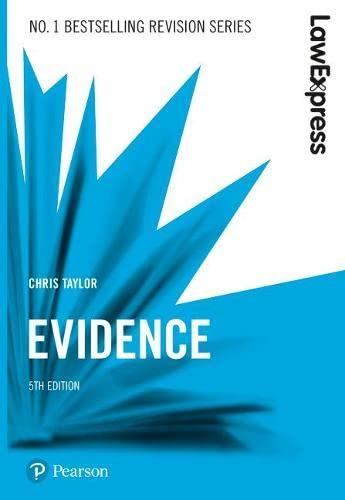Question
For each of the following three case problems, three paragraphs response including the following: 1.Identify the issue of law posed by the case problem. This
For each of the following three case problems, three paragraphs response including the following:
1.Identify the issue of law posed by the case problem. This will be in the form of a question based on a legal concept from the chapter.
2.What should be the decision in the case? (i.e. the answer to the issue)
3.The reasoning for such decision.
1.Mariana Deutsch worked as a knitwear mender and attended a school for beauticians. The sink in her apartment in Fall River, Massachusetts collapsed on her foot, fracturing her big toe and making it painful for her to stand. She claims that as a consequence of the injury she was compelled to abandon her plans to become a beautician because that job requires long periods of standing. She also asserts that she was unable to work at her current job for a month.She filed a tort claim against her landlord, Hewes Street Realty of Tiverton, Rhode Island, for negligence in failing to maintain the sink properly. She brought the suit in federal district court, claiming damages of $85,000. Hewes Street moved to dismiss the suit on the basis that the federal court lacked jurisdiction.
2.Maryland enacted a statute prohibiting any producer or refiner of petroleum products from operating retail service stations within the state. The statute also required that any producer or refiner discontinue operating its company owned retail service stations. Approximately 3,800 retail service stations in Maryland sell more than twenty different brands of gasoline. All of this gasoline is brought in from other states, as no petroleum products are produced or refined in Maryland. Only 5 percent of the total number of retailers are operated by a producer or refiner. Maryland enacted the statute because a survey conducted by the state controller indicated that gasoline stations operated by producers or refiners had received preferential treatment during periods of gasoline shortage. Seven major producers and refiners brought an action challenging the statute on the grounds that it violated the Constitution.
3.Congress enacted the National Traffic and Motor Vehicle Safety Act of 1966 (the Act) for the purpose of reducing the number of traffic accidents that result in death or personal injury. The Act directs the Secretary of Transportation to issue motor vehicle safety standards in order to improve the design and safety features of cars. The Secretary has delegated authority to promulgate safety standards to the National Highway Traffic Safety Administration (NHTSA).The Act also authorizes judicial review under the provisions of the Administrative Procedure Act (APA) of all orders establishing, amending, or revoking a federal motor vehicle safety standard issued by the NHTSA. Pursuant to the Act, the NHTSA issued Motor Vehicle Safety Standard 208, which required all cars made after September 1982 to be equipped with passive restraints (either automatic seatbelts or airbags). The cost of implementing the standard was estimated to be around $1 billion. However, early in 1981, due to changes in economic circumstances and particularly due to complaints from the automotive industry, the NHTSA rescinded Standard 208. The NHTSA had originally assumed that car manufacturers would install airbags in 60 percent of new cars and passive seatbelts in 40 percent. However, by 1981 it appeared that manufacturers were planning to install seatbelts in 99 percent of all new cars. Moreover, the majority of passive seatbelts could be easily and permanently detached by consumers. Therefore, the NHTSA felt that Standard 208 would not result in any significant safety benefits. State Farm Mutual Automobile Insurance Company (State Farm) and the National Association of Independent Insurers (NAII) filed petitions in Federal court for review of the NHTSA's rescission of Standard 208.What standard of review would apply to the rescission?Should it be set aside?Explain.
Step by Step Solution
There are 3 Steps involved in it
Step: 1

Get Instant Access to Expert-Tailored Solutions
See step-by-step solutions with expert insights and AI powered tools for academic success
Step: 2

Step: 3

Ace Your Homework with AI
Get the answers you need in no time with our AI-driven, step-by-step assistance
Get Started


